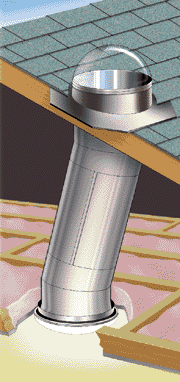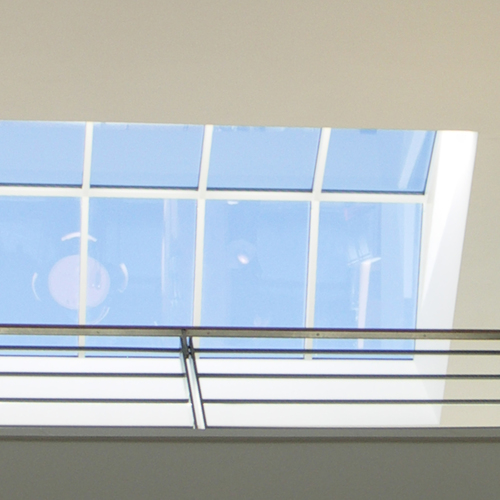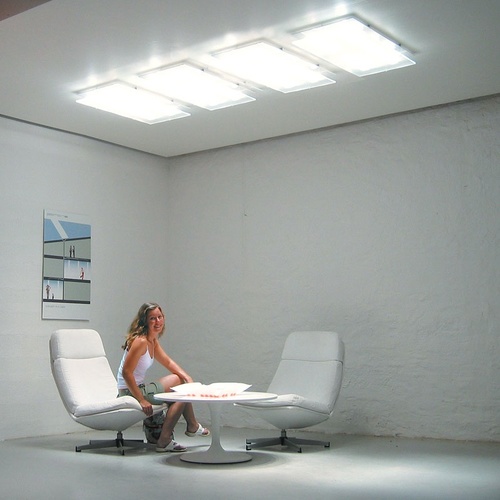
Image Credit: Solatube International
Much attention is focused on efficient lighting—from CFLs and LEDs to advanced controls. But for daytime lighting you can avoid electricity use altogether–with daylighting. Most daylighting is provided with windows or skylights (roof windows that are installed in the plane of the roof). For a lot of applications, there’s another, easier option: tubular skylights.
Tubular skylights have three components: a round, domed plastic skylight that mounts on the roof; an 8- to 22-inch-diameter cylindrical metal tube with a highly reflective interior surface that is usually less that 12 feet long, but in some cases may be over 20 feet; and a diffuser that mounts on the ceiling. Sunlight shines through the skylight dome and bounces its way downward through the reflective tube to the diffuser, which delivers the light below. For cold climates, some manufacturers offer an additional layer of glazing in the tube or diffuser to reduce heat loss back up through the tubular skylight.
While a standard skylight requires structural modifications to carry roof loads as well as a large, insulated light-well to bring the light into the living space, a tubular skylight is thin enough that it can fit between roof rafters or trusses and ceiling joists. The installation is much easier and less expensive. Most tubular skylights come with very good flashing kits to make the roof penetration weathertight–though the challenges of any roof penetration shouldn’t be underestimated, and an experienced contractor should be used.
Tubular skylights reduce daytime electricity use for lighting. Daylight is only provided only during the daytime, of course, so savings will only occur in applications where spaces are used during the daytime. It’s a great option for home offices, home daycare spaces, and homes for retired seniors—but not as good when homeowners are gone all day.
Tubular skylights are most effective in providing illumination to upper-floor or single-story houses where the ceiling is less than 10 or 12 feet from the roof. Installations in which tubular skylights extend through a second storey to provide light to a first-floor space are less common–but can be done.
The key to effective operation is the highly reflective interior surface. These aluminized surfaces often reflect more than 95% of the light striking them. But because the reflectivity is less than 100%, there are light losses with increasing length of these skylights. A tubular skylight delivering daylight through 20 feet of reflective tube will deliver significantly less light that one with just six feet of tubing. Keep that in mind when planning installations.
I haven’t lived in a house with tubular skylights, but I’ve spent time in a handful of homes, apartments, and commercial buildings with them. In a space illuminated by a tubular skylight, you’re not really aware that it’s sunlight providing the light. From the interior it looks like a fairly standard (really bright) light fixture, with the light evenly distributed by the round, typically white, diffuser. One 13-inch tubular skylight provides as much light as six or seven 100-watt incandescent light bulbs!
Some proponents of skylights point out that full-spectrum light is provided–which can help to stave off “Seasonal Affective Disorder” (SAD), which is thought to result from too little natural light during winter months.
Some products are available with integral electric lighting to provide illumination after the sun goes down. A few other add-ons from some of the dozen or so manufacturers include daylight dimming baffles that allow users to adjust the light level and integral ventilation fans, which may make sense in a bathroom or kitchen.
Costs range from about $150 at the low end to over $600 for the largest, deluxe models, plus installation. Among the leading manufacturers of tubular skylights are Solatube International, Sun-Pipe Company, Velux, HUVCO Daylighting Solutions, Daylighting Technologies, Tubular Skylight, Tru-Lite Skylights, and Sun-Tek Manufacturing.
I would avoid models that earn the 30% federal tax credit, such as the 160 DSe and 290 DSe from Solatube. They satisfy the tax credit requirements for fenestration products by using glazing that limits the U-Factor to 0.28 and solar heat gain coefficient (SHGC) to 0.20 (less than the maximum 0.30 for each). I like the U-Factor limit, but the low SHGC may not make sense for a product designed to deliver daylight. For less solar gain (and illumination), just install a smaller-diameter tubular skylight.
I invite you to share comments on this blog. What’s your experience been with tubular skylights?
Alex Wilson is the executive editor of Environmental Building News and founder of BuildingGreen, LLC. To keep up with his latest articles and musings, you can sign up for his Twitter feeds.
Weekly Newsletter
Get building science and energy efficiency advice, plus special offers, in your inbox.















25 Comments
I've used these often and
I've used these often and have had good luck with them. Better than traditional skylights with all the benefits mentioned in the post, additionally, you don't get the big energy penalty (large volume through unconditioned attic) that you do with traditional skylights. They make a good night light on clear nights. For basements, I've installed them through the side walls with good results---Much easier than going through the roof, attic and first floor (and framing a first story chase).
Agreed
We've used them as well with good results. In one project in-town, there's enough light pollution at night that it functions quite well as a night-light. Can be a little tricky if poking thru a flat roof.
love them, but also love the vented skylight
I have installed many sun tunnels, and they work very well for spaces which truly require the daylight, such as hallways. I do admit, however, that a good manually vented / shaded skylight in the right location can not only provide a better aesthetic presence in a public room, but also provide great ventilation options when a client is trying to hold off on starting up their air conditioning system in the spring.
basement installation
Hi John - curious about the basement installation. I've been considering this as an option for a renovation project.
Did you just install horizontally instead of vertically? Are there any shading considerations (e.g. from building, plantings, etc).
Thanks much.
Heat loss with tubular skylights
Are there data on the thermal performance of tubular skylights ?
Interesting question Interested
I have 2 in my home and I like the daylight provided..
in my case they pass thru a conditioned attic.
I still have to wonder about the airtightness and u-value at the top, the bottom and the heat transfer along the shaft.
In the case case of a not conditioned attic .. I would think that the heat transfer along the shaft could be considerable.
Sidewall Installation
George,
The sidewall one I put on was the westside, with a very nearby building. There are no plantings nearby. It's flashed just like any other wall penetration.
When we run them through an unconditioned attic, I run about the first 3 feet or so in a Sonotube (concrete form) that is 2" bigger than the sun tube. For instance, if we have a 10" sun tube, we use a 12" Sonotube. I air seal the bottom of the sun tube at the ceiling , then fill the remainder of the sonotube/suntube space with cellulose (I'm not sure if this step is necessary, but it also protects the flimsy sun tubes). I haven't had any condensation problems with this. The diffusers seem to air seal pretty well against the ceiling. The blower door/infrared doesn't show leaking..
Less uninsulated volume than a tradittional skylight, but it's still a 10" uninsulated hole in the ceiling.
Great for the do-it-yourself crowd
As a homeowner I think that they are great. I installed one myself in a formerly dark upstairs hallway. It was nice not having to mess with any structural members in the roof or ceiling. My wife raves about it.
sidewall installation
Hi again John,
Just to make sure I'm understanding correctly. On the interior, you have the light diffuser mounted on the wall instead of the ceiling? It penetrates the wall horizontally and as you said flashed like any other wall penetration. Do you leave the skylight portion horizontal as well (and if so, no leaking issues even though its meant to be vertical?) or do you put a 90 degree bend in (and if so, how do you go about doing so? and how high do you run it?)
I'm guessing since it's lower and in a more shaded position it lets in significantly less light than a vertical installation in full light on a roof - but obviously still enough to be worthwhile?
Thanks again for the info.
Caveats
A few caveats:
1. they work best in spaces which have no other source of daylight. They can seldom compete with real windows.
2. reflectivity of the wall and floor surfaces within the lighted space is important. I've seen half a dozen of these installed in a paneled ranch house living room, and it was still gloomy.
3. just like recessed can lights, these can be problematic in terms of air leakage. Unless impeccably installed, you may waste more energy than you save.
Tube lights and light color
We are a sustainable design company based in Panama (the country), we have found you have to be a bit careful because the light they produce is quite shocking and blue which is unpleasant. To counter this we put a sheet of yellow tracing paper on top of the clear plastic that is in the room.
You can add more sheet to dampen it down or warm it up more.
Solatube success
My wife and I installed two Solatubes in our new house; a 10" diameter unit in the interior office and an 8" diameter unit in the walk-in closet. Both give excellent light, especially in the office where the light coloured walls act as illuminated surfaces that bathe the room in light.
I haven't tried it yet, but Solatube claims to be able to shoot sunlight as much as 30' down, so that with careful design and housing the reflecting tube within wall cavities you can light the basement of a two story house. However, the extra lengths of reflective tubing would not be cheap.
We chose the Solatube because it had the highest reflectivity factor of the units available in our area and we've been quite happy with our choice.
Jef Keighley,
Halfmoon Bay,
British Columbia, Canada
Sidewall Installation
George,
If you want, send me your email to [email protected] and I'll send you some pics. But, yes, we just mount it like a port window on a ship and on the interior, it too is on the wall. It puts off good light even when the sun is opposite the wall (it;s still picking up daylight). And the run is about 18' with one 45 bend where it terminates on the interior.
Thermal Data
Solatubes have a .43 U-factor which qualifies it as an Energy Star rated product. If you get the E-choice model it bumps it down to a .30 U-factor and qualifies for a 30% federal Tax Credit. The tax credit apply's to the product cost and not the installation.
Installation issues
I saw one in a bathroom that was problematic. The effect on the day I was there was equivalent to a low end florescent fixture. More importantly the diffuser had signs of mildew on the inside. When I went up in the attic I saw the contractor had removed insulation from the ceiling plane, there was no air sealing and the tube run was uninsulated. This is in upstate NY. Its important especially in high humidity areas to use best penetration practices and treat chase ways through unconditioned areas with all the same detail you would that interior surfaces mandate especially to prevent condensation and subsequent mold not to mention the energy penalty. Love the concept but success is always achieved best in the details. Hopefully manufactures are guiding installers in the proper installation of these products.
Net Energy Balance
Hi Alex: do you know if these devices transmit infrared spectrum radiation in addition to visible light spectrum? If so, there may be an A/C energy penalty in cooling climates, in addition to the lower R value "penetration hole" in the building envelope. I wonder if a CFL or LED light bulb with an occupancy sensor might be a much less expensive installation, with lower operating energy net usage, with less flashing/water leak risk, for most installations such as in a dark hallway. BTW the latter alternative has the advantage of working during night time too.
Solar heat gain and insulation issues
Good questions. One manufacturer offers a tubular skylights that achieves the "30-30" threshold for windows to satisfy the 30% federal tax credit. That means a U-factor below 0.30 and a solar heat gain coefficient below 0.30--which I suggest may not make sense (installing a product with such a low SHGC). I'd love to see good test results that would answer your questions. As for light output compared with CFL or LED lighting, the lumen output from tubular skylights is typically far higher than that from most CFL or LED fixtures, so a simple one-for-one comparison may not be relevant.
Anyone else have input on the A/C load penalty of tubular skylights or the effective insulation value? (With vertical heat flow through glazings and air spaces the heat loss is heavily affected by convection--so R-value-based heat loss calculations may not be accurate.)
lumen output
Rated lumen output from a tube skylight is seldom the critical factor. The diffuse light from these fixtures may be sufficient for daylight walkthrough of an interior hallway (though leaving the adjacent room doors open may be just as effective) but many would find it inadequate for personal grooming in an otherwise unlit bathroom. Mike had it right: "equivalent to a low end florescent fixture": I would add 'an often poorly located low end fluorescent fixture'. Good lighting design requires more than horsepower (lumens) and if you want your tube light to be useful for more than just finding the light switch you will have to give more thought to placement than is generally shown.
And if environmental concerns mean anything to you, please bear in mind that you are putting an R5 hole in an R38+ ceiling, and the ongoing energy costs of the installation (both by transmission and air leakage) will be incurred 24/7, while the energy benefit, especially if the space is used only sporadically, may be marginal or nonexistent. Tax credits, attractive as they may be, are not a reliable guide to environmental performance. I believe that most homeowners could find far better use for the $300-$500 cost of a light tube.
Excellent post!
James,
Well said. I agree with you.
I wanted to put one of these
I wanted to put one of these in my dark kitchen. Ideally I would like to install it in a corner of the room, but am worried about light distribution in this corner. There would be a shelf about 20 inches below the tube and there is a cupboard on 1 one side and wall on 2 other sides, leaving 1 side open to the rest of the room. I am afriad most of the light will be absorbed by that corner and shelf. Should I choose another spt?
Response to Alisha Clark
Alisha,
If there is a shelf directly below the spot you have chosen, I think it would be wiser to move the proposed skylight in the direction of the center of the room, away from the shelf.
Through window
I have a 1st floor living room in an attached house (attached from both sides) and this room runs north south and has some windows on the south-facing side. Above this room is a 2nd floor and then the roof. Instead of running the tubes from the roof, can I instead point it somehow on the south-side facing windows?
Response to Sam Dhak
Sam,
You are double-posting this question. My answer is the same, regardless of which page you post your question on.
You can read my two answers to your question here: Lighting strategies.
Tubular Skylights saves a lot of energy
Tubular Skylights are beneficial to our company because we operate during daytime only. After installation we made a case study on how much energy is saved after installation. See our case study here: http://www.eco.ph/downloads/Commercial-CS.pdf
Response to Rhena Edora
Rhena,
When it comes to analyzing energy savings in residential applications, your "study" is of little use, for two reasons:
1. I don't see any information at all on heating and cooling costs before and after the retrofit, so we have no idea how much more spacing heating or space cooling energy was needed after these tubular skylights were installed.
2. The application is a commercial warehouse, where workers need lighting during the daytime and where indoor lighting is usually left on all day. That's very different from a typical residence, where (at least in most homes) no one is home during the middle of the day.
Log in or create an account to post a comment.
Sign up Log in